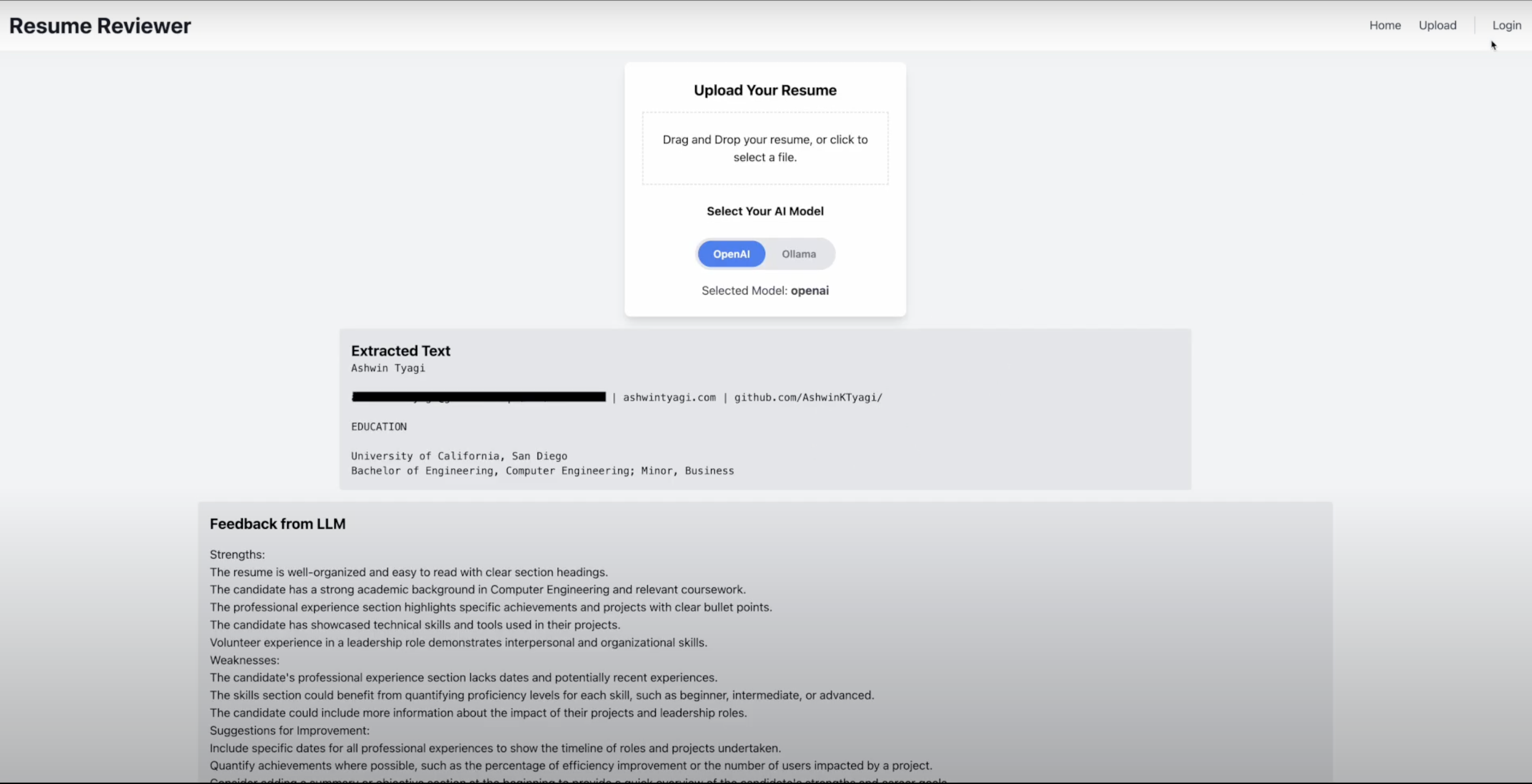Link to Project’s Github
Description
I developed an app that allows users to upload their resumes in PDF or DOCX format. The backend extracts the text from the uploaded resume and processes it using a large language model to provide feedback.

Backend Techstack
Routing
- FastAPI
Document Processing
- pdfminer
- python-docx
LLM Support
- OpenAI API
- OLLaMa
- LangChain Community Embeddings
Storage and Authentication
- MongoDB
- FastAPI's JWT Auth
Frontend Techstack
App Construction
- NextJS
Styling
- TailwindCSS
- React Dropzone/Markdown
Features
Resume Document Processing
The first step in the resume review pipeline occurs where uploaded documents are parsed and prepped for analysis. Here is the process:
- File Upload
- Users can upload resumes in PDF or DOCX format through the frontend interface
- Once uploaded, the file is sent to the
FastAPIbackend for processing
- Text Extraction
- The backend extracts clean text content from the document using
pdfminerorpython-docx. - The text is then prepped for downstream analysis by the LLM.
- The backend extracts clean text content from the document using
- Caching & Deduplication
- Before submitting the extracted text to the LLM, the backend checks
MongoDBto see if the same document has already been processed. - If a match is found, the backend returns the cached result, avoiding redundant processing and minimizing compute usage.
- This optimization helps reduce unnecessary calls to
OpenAI’s API or a localOllama-hostedLLaMA 2instance, saving both time and money.
- Before submitting the extracted text to the LLM, the backend checks
Authentication
To ensure secure access to resume-data and the AI-generated insights, the user’s information is protected by a simple but effective authentication flow. Here is how I handled it:
- User Registration
- New users can create an account by providing an email and password.
- Passwords are hashed and salted using a secure algorithm (
bcrypt) before being stored inMongoDB.
- User Login
- Returning users can log in with their credentials.
- The backend verifies the email and compares the submitted password with the stored hash.
- Session Management
- On successful registration and login, the user is assigned a new
JWTtoken which the frontend stores and uses for subsequent requests. - These tokens are inclueded in the Auth header of every request to protected endpoints.
- The
FastAPIuses middleware to decode and verify each token so that only authenticated users can access and modify data
- On successful registration and login, the user is assigned a new
- User-Specific Data Access
- Almost every database action is linked to a user’s ID, which is extracted from the token.
- This ensures data isolation so users can only access and interact with their own content.
Chat System with RAG
The resume reviewer includes a chat interface where users can ask questions or request more feedback about a specific resume. This feature is powered by a Retrieval-Augmented Generation (RAG) Approach, which enables context-aware, document-specifc responses. Here’s how it works:
- Message Submission
- Users submit questions via the frontend chat UI.
- The query, along with the user’s file_id is sent to the backend.
- Context Retrieval
- The backend looks up the resume associated with the file_id in
MongoDBand retrieves the latest extracted text.
- The backend looks up the resume associated with the file_id in
- RAG Construction
- A RAG prompt is built by combining
- the users question: {query}
- the retrieved resume text and chat history: {context}
- This prompt is designed to anchor the LLM’s generation in document-specific data, in order to improve consistency and relevance.
- A RAG prompt is built by combining
- Conversation Persistence
- The user’s message and AI’s reply are appended to a chat_history array associated to the document in
MongoDB. - This allows the frontend to display a continuous and contextual conversation
- The user’s message and AI’s reply are appended to a chat_history array associated to the document in
Future Plans
Handle Vector Embeddings
- Embedding-Based Job Matching
- The goal is to compare a user’s resume embedding to those of successful, accepted resumes for specific job roles.
- By computing cosine similarity between vectors, the system can provide a relevance score and actionable feedback
- Improved RAG Context Filtering
- Embeddings can also help narrow down which parts of the resume to include as context for RAG-style prompts—especially useful when the resume is long or highly technical.